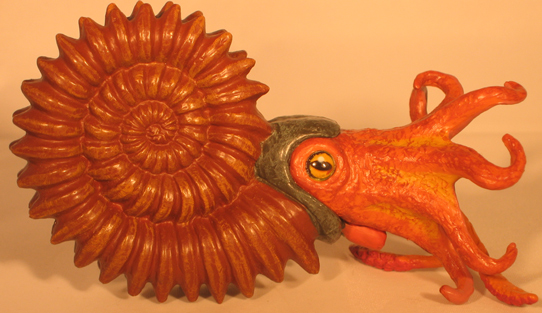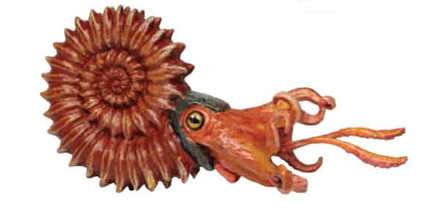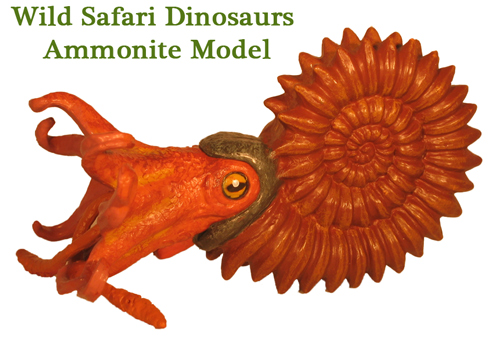A Review of the Wild Safari Dinosaurs Ammonite Model
The design team at Safari Ltd have produced a number of prehistoric animal replicas over the years, broadening the scope of their Wild Safari Dinosaurs range to include other extinct creatures and not just dinosaurs. In 2014, a model of an ammonite was introduced to the delight of teachers, fossil hunters and model collectors alike.
Wild Safari Dinosaurs Ammonite
The Ammonite Model (Wild Safari Dinosaurs)
Studying Cephalopods
Ammonites are an extinct group of cephalopods, that belong to the extremely diverse Mollusca phylum. Ammonite fossils, because of their abundance and variety, are very important to geologists and palaeontologists. Along with two other types of Mollusc, the bivalves and the gastropods, (for example snails), ammonite fossils help scientists to date geological strata relative to other rock formations.
Closely related to living cephalopods such as squid, the nautilus and cuttlefish, ammonites lived in chambered shells. In most species the shells were coiled round and the animal lived in the last section of the outer whorl of the coil, in what is referred to as the body chamber. The shells made of aragonite, a form of calcium carbonate, are extremely numerous in the fossil record, although the soft parts, the ammonite’s actual body tissues are virtually unknown.
Describing an Ammonite
It is believed that ammonites had eight, grasping arms and two much larger tentacles. These two tentacles had many suckers on the end which helped these animals grab prey. It is likely that because of the variety and diversity of ammonite species, that these creatures occupied a number of niches in marine food webs. For example, large actively swimming species could have hunted fish, crustaceans or jellyfish, others may have been scavengers, many smaller species probably fed on plankton.
The Ammonite Model from Safari Ltd

A great ammonite model for use in schools, museums and for model collectors. Picture credit: Everything Dinosaur.
Picture credit: Everything Dinosaur
The Safari Ltd replica is beautifully painted, the coiled shell being a metallic bronze colour, the body chamber battleship grey with the animal itself painted in subtle oranges and pinks. Note the large eye, like modern cephalopods such as squid and cuttlefish, ammonites very probably had excellent eyesight. They were probably visual hunters, their large eyes giving them excellent peripheral vision to help them avoid predators.
When viewed from the front, a good view of the muscular arms can be obtained. The two specialised tentacles are painted a lighter colour and can be seen projecting downwards. The ends, of these two tentacles have been provided with a number of round suckers by the design team at Safari Ltd, these represent the soft, fleshy pad called the dactylus, the apparatus with which the ammonite could grasp and secure prey.
A View from the Front (Anterior View) of the Ammonite Model
Picture credit: Everything Dinosaur
Projecting out from underneath is the hypernome, a narrow, muscular tube that squirted water, providing the ammonite with a form of jet propulsion.
Describing the Shell
The shell has very prominent ribs which are raised in the last whorl of the shell to form two rows of parallel spines. Such ornamentation would have helped protect the ammonite from attack, perhaps deterring a marine reptile such as a mosasaur from taking a bite. Whilst these spines would have assisted with the animal’s defence, they do not help much with streamlining. It may be difficult to identify the precise species that the sculptors at Safari Ltd have based their model on, but due to the shape of the shell, those large ribs and projecting points, the model probably represents quite a slow swimming species.
The Wild Safari Dinosaurs Ammonite Model
Picture credit: Everything Dinosaur
This ammonite measures a fraction under eleven centimetres in length and the shell has a diameter of six and a half centimetres. It is not possible to put a scale on this figure, most ammonite species were small, with shells only a few centimetres across, although the fossil record has preserved the remains of some giant forms with shells in excess of two metres in diameter.
To view the range of Safari Ltd models: Safari Ltd. Prehistoric Animal Models.
It is great to see a replica of an ammonite added to the Wild Safari Dinos model range. It is ideal for use in schools as an inexpensive teaching aid when exploring fossils and in addition it can be added to the display cases of ammonite fossil material to give viewers an appreciation of what the animal actually may have looked like.
This is an exciting addition to the Wild Safari Dinosaurs model range made by Safari Ltd and it means that Everything Dinosaur now has an ammonite replica to supply to model collectors and fans of prehistoric animals. We even supply a fact sheet all about ammonites and this will be sent out with model sales.









Leave A Comment